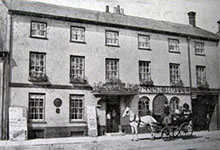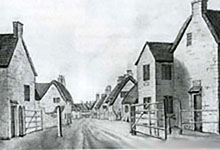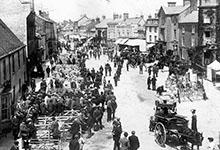Timeline
Bicester Local History Society has created this Timeline from their archive of pictures and artefacts. The Society would welcome any historical images or artefacts that would be suitable for inclusion in the Bicester Timeline. Please contact the Society if you are able to help in this way.
 |
| 300 Million B.C |
| The Carboniferous Period |
| The Bicester area was covered by Tropical Forests. Coal deposits can be found deep under the town. |
 |
| 150 Million B.C |
| The Jurassic Period |
| Dinosaurs roamed around the area. Their footprints have been found at Ardley Quarry. |
 |
| 3 Million B.C |
| The Ice Age |
| The last Ice Age brought arctic conditions to the Bicester region and did much to shape the present landscape. |
 |
| 500,000 B.C |
| The Paleolithic Period |
| Small groups of early Humans and Neanderthals would have crossed the region. |
 |
| 4,000 B.C |
| The Mesolithic Period |
| Bands of Mesolithic hunter/gathers set up camps near the river Bure. They left evidence of being the first people to live in Bicester. |
 |
| 2,000 B.C |
| The Bronze Age |
| Bronze Age settlers began to clear the forests and settled as the first farmers in the Bicester area. |
 |
| 1500,000 B.C |
| Bronze Age Barrows |
| Important evidence of Bronze Age barrows has been discovered close to the Kingsmere development to the south of the town. |
 |
| 800 B.C |
| The Iron Age |
| Evidence of Iron Age settlement in the area is widespread. The farmers traded with tribes in other parts of the country. |
 |
| 50 B.C |
| Iron Age Settlement |
| Excavations at Fields Farm revealed a late Iron Age Roundhouse. A number of animal sacrifices were found buried in ditches close to the house. |
 |
| 43 A.D |
| Roman Occupation |
| A large Legionary Fort was built at Alchester, a mile south of Bicester. The future Emperor Vespasian was among the troops to serve there. |
 |
| 60 A.D |
| Alchester Tombstone |
| A rare Roman tombstone was excavated on the Alchester site that described the life of a soldier who served at the fort. |
 |
| 100 A.D |
| Roman Roads |
| The Romans built a network of roads in the area, such as Akeman Street, which is still in use today. |
 |
| 100 A.D |
| Roman Temple |
| An important Roman Temple was built at Woodeaton. Archaeological finds from the site can be seen at the Ashmolean Museum in Oxford. |
 |
| 410 A.D |
| Local Conflicts |
| The area became unsettled when the Romans left. The Romano-British residents fought with surrounding tribes at this time. |
 |
| 630 A.D |
| Bicester Founded |
| A settlement we now call Bicester was established on the present site of the town when it became impossible to continue to occupy the old Roman town of Alchester. |
 |
| 700 A.D |
| Saxon Settlement |
| The Saxon settlement at Bicester had grown to include a substantial church and dwellings on both sides of the River Bure. |
 |
| 800 A.D |
| Early Growth |
| Excavations at Saxon Court, in Chapel Street, identified a number of phases linked with the Saxon town's early growth. |
 |
| 900 A.D |
| Saxon Window |
| An ancient Saxon window can be found in the tower of Caversfield Church. The oldest surviving example in the area. |
 |
| 912 A.D |
| Viking Invasion |
| Bicester was attacked and destroyed by the Danes. |
 |
| 1005 |
| Edward the Confessor |
| Edward the Confessor, one of the last Saxon Kings, was born at Islip. |
 |
| 1086 |
| The Domesday Book |
| Bicester (Bernecestre) is recorded as a settlement of two Manors and home to about two hundred people. The Lord of the Manor was Robert d'Oilly. |
 |
| 1104 |
| St Edburg's Church |
| Built and extended throughout the Middle Ages, the earliest record of it dates from 1104. |
 |
| 1150 |
| Open Field System |
| Mediaeval Open Fields surrounded the town and other local villages. Farming was the main occupation. |
 |
| 1182 |
| Bicester Priory |
| Gilbert Bassett founded a Priory in the town. This contained the Shrine of the Saxon Saint Edburg, and was visited by many pilgrims. |
 |
| 1239 |
| The Market |
| A licence was granted by King Henry III to hold a market in the present Market Square. A market to be held at King's End was granted a licence in 1377. |
 |
| 1255 |
| Lower Heyford |
| A notable mediaeval bridge crosses the River Cherwell at Lower Heyford. |
 |
| 1300 |
| Tithe Barns |
| A number of Tithe Barns had been built by this time to store crops. A fine example is still to be found at Upper Heyford. |
 |
| 1349 |
| The Black Death |
| The plague hit Bicester, though no records survive of how many deaths it caused in the area. |
 |
| 25th May 1355 |
| St John's Hospital |
| Nicholas Jordon was granted a licence by King Edward III to build the hospital of St John for the relief of the sick and poor. |
 |
| 1536 |
| The Dissolution |
| Bicester Priory was surrendered to King Henry VIII and its treasures seized. The Priory Church was demolished. |
 |
| 1549 |
| Public Hanging |
| Richard Whyttington was hung in Bicester for taking part in the Buckingham and Oxfordshire Uprising. |
 |
| 1577 |
| The Shambles |
| The Shambles and Town House were erected in the Market Square. They were demolished after a riot in 1826. |
 |
| 1642 |
| The Civil War |
| The Bicester area was fought over at various times during The English Civil War. Both Oliver Cromwell and King Charles I are reputed to have spent time in the town. |
 |
| 1682 |
| The Six Bells |
| The Six Bells, in Church Street, was built. The terrace contains a number of properties dating from this period that can be identified by date stones placed in their walls. |
 |
| 1700 |
| Coaching Inns |
| A number of Bicester Coaching Inns became established such as The Kings Arms and The Crown. |
 |
| 1700 |
| Toll Roads |
| Toll roads were constructed to improve communication which had deteriorated since medieval times. North Street was the site of an early toll gate. |
 |
| 1700 |
| Country Estates |
| The wealthy gentry built large country estates in the area and created impressive parks and gardens such as those at Kirtlington, Bletchingdon and Rousham. |
 |
| 1724 |
| Water Lane Fire |
| Fire ravages a part of Water Lane (Chapel Street) causing considerable damage. |
 |
| 1729 |
| Congregational Church |
| The Congregational Church was built in Chapel Street in the area destroyed by fire. |
 |
| 1732 |
| Town House Bell |
| Edward Hemmings cast the bell for the old Town House. It is now displayed at the entrance to The Garth Park. |
 |
| 1753 |
| Enclosure Act |
| Bicester's Open Fields system was enclosed to improve agricultural efficiency. This was responsible for the countryside pattern we see today. |
 |
| 1778 |
| Bicester Hunt |
| The Bicester Hunt was founded. The hunt was a popular pastime for the gentry and attracted members from as far as London. |
 |
| 1784 |
| Balloon Flight |
| James Sadler made one of the first successful balloon flights from Oxford to Woodeaton. |
 |
| 1790 |
| Oxford Canal |
| The Oxford Canal was completed which aided the transport of goods throughout the country. |
 |
| 1795 |
| First Stage-Coach |
| The first stage-coach ran from Bicester to London. |
 |
| 1830 |
| Otmoor Riots |
| Rioters on Otmoor rebelled against the agricultural reforms. |
 |
| 24th May 1830 |
| Pauper Emigration |
| A hundred pauper emigrants leave Bicester for North America. |
 |
| June 1832 |
| Cholera Epidemic |
| Cholera outbreak killed 64 residents of Bicester in six weeks. A memorial stone (pictured) can be found in the Churchyard. |
 |
| 1836 |
| Bicester Workhouse |
| A purpose built Workhouse was opened at Highfield. It was demolished in 1966. |
 |
| 1845 |
| Mains Gas |
| Gas was brought to Bicester in 1845. The photograph of the top of Sheep Street shows a gas lamp used for street lighting. |
 |
| 1st October 1850 |
| Oxford-Bletchley Railway |
| The Oxford to Bletchley railway was opened. A station was built at London Road. |
 |
| 1857 |
| Police House & Courthouse |
| The Police Station in Church Street was built. Shortly after the Courthouse was built next door. |
 |
| 1st June 1859 |
| Bicester National Schools |
| Bicester National School was opened at the top of Cemetery Road. It later became St Edburg's Primary School. |
 |
| 1865 |
| County Court |
| The County Court Hall in Sheep Street was first used. |
 |
| 24th December 1874 |
| Hampton Gay Disaster |
| The worst recorded railway disaster of the Victorian era took place at Hampton Gay on 24th December 1874. Thirty passengers were killed. |
 |
| 13th December 1882 |
| St Edburg's Hall |
| St Edburg's Hall was opened and became a valued venue for recreational functions for many years. |
 |
| 1888 |
| Lord Jersey Cup |
| The Lord Jersey Challenge Football Cup is one of the oldest competitions in the country. The 1888 winners are pictured above. |
 |
| 1905 |
| Mains Water |
| Mains water was piped through the town. |
 |
| 1906 |
| Great Western Railway |
| Construction of the Great Western Railway (Bicester North) commenced. The line opened in 1910. |
 |
| 1910 |
| Cattle Market |
| The final Cattle Market took place in Sheep Street. The market then moved to a new site in Victoria Road. |
 |
| 1911 |
| Forced Landing |
| An aeroplane made a forced landing near to Launton. |
 |
| 1914 |
| Bicester VAD Hospital |
| Bicester Hall (Hometree House) was used as a troop hospital during the First World War. |
 |
| 1918 |
| Bicester Aerodrome |
| Bicester Aerodrome was opened to train Flying Corps pilots towards the end of the First World War. |
 |
| 19th September 1924 |
| County School |
| Bicester County School was opened at Bicester Hall with forty three pupils. |
 |
| 29th June 1933 |
| Open Air Swimming Pool |
| Bicester Open Air Swimming Pool, built by the Causeway, was opened. |
 |
| 1939 |
| Evacuees |
| Bicester received many evacuees from London at the start of the Second World War. |
 |
| 1939 |
| Prototype Test Flights |
| Secret flights of the prototype Halifax heavy bomber took place at R.A.F. Bicester. |
 |
| October 1939 |
| Causeway Flooding |
| Serious flooding took place in the Causeway. |
 |
| July 1940 |
| George VI Visit |
| King George VI visited Bicester Aerodrome. |
 |
| 1941 |
| Bicester COD |
| Construction began at the Central Ordinance Depot, Bicester. It was to become one of the armed forces major supply bases in the Second World War. |
 |
| 1954 |
| Plane Crash |
| An R.A.F. training plane crashed into houses in Priory Road. |
 |
| 1963 |
| Hedges Block Demolished |
| Hedges Block, for many years a dominant feature of Market Hill, was demolished as part of a road widening scheme. |
 |
| 10th May 1965 |
| Royal Visit |
| Queen Elizabeth II visited Bicester Ordnance Depot, and the town, for the first time. |
 |
| 1980 |
| RAF Upper Heyford |
| R.A.F. Upper Heyford became an important airbase for the United States Air Force during the Cold War. F111 bombers from the base carried nuclear weapons. |
 |
| 26th November 1988 |
| Crown Walk Opened |
| The Crown Walk Shopping Centre opened as part of a town centre redevelopment scheme. |
 |
| January 1991 |
| M40 Motorway |
| The M40 motorway linking London and Birmingham opened in January 1991. It has had a major effect on traffic use in the area. |
 |
| 1994 |
| Pedestrianisation |
| Sheep Street was fully pedestrianised. It remains one of the important shopping centres in the town. |
 |
| 26th April 1995 |
| Bicester Village |
| Bicester Village Retail Outlet attracts over three million shoppers a year. It is a major tourist attraction in the area. |
Please use the horizontal scroll bar above to access the information on the Timeline. We hope that you enjoy your journey through the heritage and history of our area.
A more detailed chronology can be viewed here.
Copyright: While every effort has been made to contact the copyright owners of the pictures used in the Timeline, it is possible that some have not been traced. Those concerned are asked to accept the Society’s apologies.
